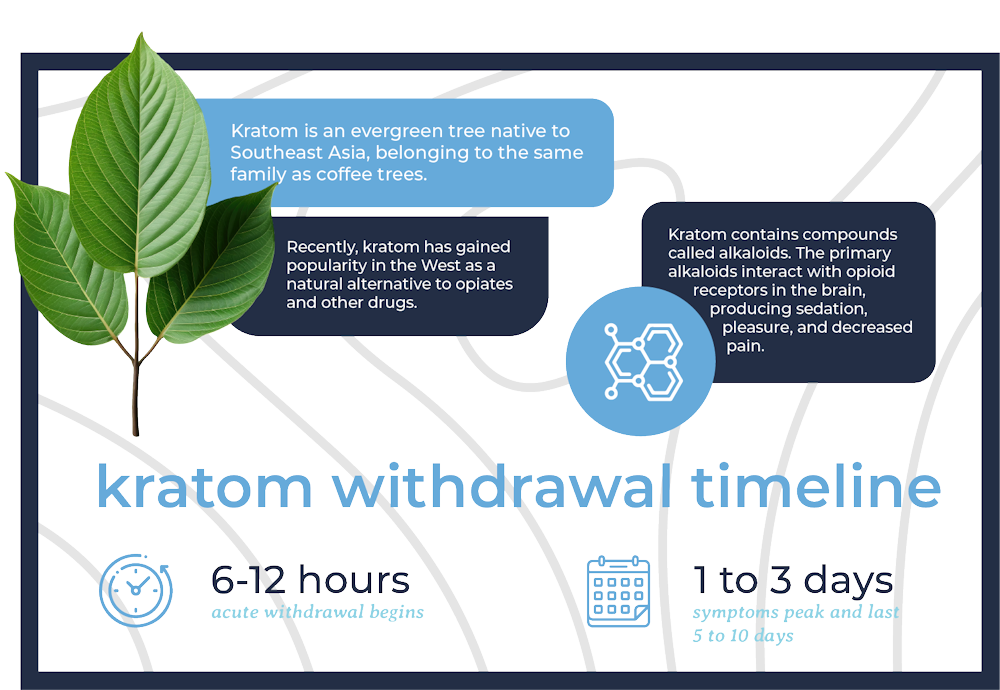Kratom has an online reputation for being a safe alternative to manmade opioids. That’s incorrect. Rather, the substance has addictive properties that can lead to unpleasant withdrawal symptoms. In this blog, we’ll discuss what a typical kratom withdrawal timeline looks like.
Our addiction treatment programs in Portland, OR treat kratom substance use disorder along with any co-occurring mental health issues.
What is Kratom?
Kratom is an evergreen tree native to Southeast Asia, belonging to the same family as coffee trees. It has been used in traditional medicine for centuries, with effects ranging from stimulation and relaxation to pain relief and improved sleep patterns. Recently, kratom has gained popularity in the West as a natural alternative to opiates and other drugs.
Kratom is available in various forms, from powder form and capsules to tea and extracts. It can be taken as a supplement or enjoyed as a beverage. Kratom has both energizing and soothing effects, depending on the strain and dosage. The leaves of the kratom tree contain compounds called alkaloids, which interact with the body’s receptors to produce various effects.
Who Takes Kratom?
Kratom is becoming increasingly popular with people from all walks of life. It’s not just the health-minded looking for an alternative. Athletes, working professionals, and students have embraced kratom as a way to help them through the day.
A friend might have turned you on to this herbal substance as a way to boost energy. You may be dealing with pain and want an alternative to prescription pain pills. Because you can drink the herb as a tea, it’s easy to incorporate with a meal and may be perceived as healthy.
However, kratom isn’t a consequence-free substance. It carries some risks, including possible addiction and increased risk of overdose. Learn about addiction treatment in Portland, OR.
Kratom Withdrawal Timeline: Stages and What to Expect

The kratom withdrawal timeline typically unfolds in several stages, each marked by different physical and psychological changes. While the exact duration and intensity can vary depending on the individual’s kratom use habits, such as frequency and higher doses, the process generally follows a recognizable pattern. Here’s a breakdown of each stage and what individuals can expect after stopping kratom:
The first symptoms of kratom withdrawal usually appear within 6 to 12 hours after the last dose, though this can vary depending on factors like tolerance and metabolism. During this stage, individuals may begin to experience mild physical symptoms, such as:
- Runny nose
- Sweating
- Muscle aches
- Stomach discomfort
At this point, the body begins adjusting to the absence of kratom, as the drug no longer activates the opioid receptors it normally binds to in the brain. Many people also report feeling restless or irritable during this early stage.
The acute phase of kratom withdrawal usually peaks between 24 and 72 hours after stopping use. This stage is often the most intense, as both physical and psychological symptoms reach their maximum severity. During this period, individuals may experience:
- Severe pain and muscle aches
- Intense abdominal pain and cramping
- Flu-like symptoms, including chills, sweating, and runny nose
- High blood pressure
- Insomnia and difficulty sleeping
- Irritability and mood swings
- Anxiety, agitation, and depression
- Severe withdrawal symptoms, such as cravings and overwhelming discomfort
These symptoms are similar to opioid withdrawal due to the way kratom interacts with the same receptors in the brain, leading to a challenging and uncomfortable few days.
As the acute symptoms start to subside, the subacute phase begins. This stage, which occurs 3 to 7 days after the last dose, marks a gradual reduction in the severity of physical symptoms. However, psychological symptoms may persist or even intensify, as the brain struggles to rebalance its brain chemistry without kratom’s effects.
Symptoms during this phase may include:
- Lingering symptoms of fatigue or weakness
- Continued stomach discomfort or gastrointestinal upset
- Cravings for kratom or other substances
- Irritability, anxiety, and difficulty concentrating
- Insomnia or disrupted sleep patterns
While the physical symptoms like muscle aches and flu-like symptoms generally begin to fade, the psychological impact of withdrawal often persists and severe symptoms can be particularly difficult to manage without support.
For some individuals, kratom withdrawal does not fully end after the first week. Instead, they may experience Post-Acute Withdrawal Syndrome (PAWS), a condition where psychological kratom withdrawal symptoms linger for weeks or even months after stopping kratom use. Common symptoms of PAWS include:
- Persistent anxiety or depression
- Low energy or chronic fatigue
- Ongoing cravings for kratom or other substances
- Sleep disturbances or insomnia
- Emotional instability and mood swings
- Difficulty focusing or maintaining attention
These long-term symptoms can increase the risk of relapse, as individuals may turn back to kratom or other substances to alleviate their discomfort. However, with the help of our aftercare program, PAWS can be managed effectively.
Factors Influencing Kratom Withdrawal Timeline
Several factors can influence the severity and duration of kratom withdrawal:
- Dosage: Individuals who regularly use higher doses of kratom are likely to experience more intense withdrawal symptoms over a longer period.
- Duration of Use: Long-term kratom users may face a longer and more difficult withdrawal process than those who have only used the drug for a short period.
- Other Substances: Those using kratom alongside other substances, such as prescription drugs or opioids, may experience a more complex withdrawal due to interactions between the drugs.
- Health Conditions: Underlying health conditions, such as mental disorders or chronic pain, can make withdrawal symptoms more challenging and prolonged.
Kratom Withdrawal Symptoms
Common Kratom withdrawal symptoms can be physical or mental. Withdrawal can be dangerous and should be done under medical supervision.
- Muscle aches and pain: One of the most reported symptoms, with users experiencing discomfort in their limbs and back.
- Fatigue: Individuals often feel physically exhausted, even with little activity.
- Nausea and vomiting: The body may react to the absence of kratom with gastrointestinal distress.
- Diarrhea: Digestive issues are common, with many users reporting diarrhea during withdrawal.
- Sweating and chills: Sudden, excessive sweating and cold chills may occur, similar to flu-like symptoms.
- Fever: Some individuals experience mild fevers during the withdrawal process.
- Restlessness: A sense of physical and mental agitation can make it difficult to stay still or relax.
- Anxiety: Many individuals feel increased anxiety, ranging from mild unease to severe panic. Get help at our anxiety treatment center.
- Depression: Withdrawal can trigger mood swings or even deeper depressive episodes, making recovery challenging.
- Irritability: Irritability and frustration often emerge, especially in the early stages of withdrawal.
- Insomnia: Sleep disturbances are common, with some individuals struggling to fall or stay asleep.
- Cravings: As with most addictive substances, users may experience strong cravings to return to kratom use.
Overcoming an Addiction to Kratom

Don’t be misled by the assumption that herbs are always safe. Overcoming kratom addiction often mirrors the process of breaking free from opioid dependency, requiring structured support and targeted therapies. A comprehensive kratom addiction treatment program typically includes:
For individuals with co-occurring mental health conditions, Crestview provides dual diagnosis treatment, ensuring that both the addiction and underlying mental health disorders, such as anxiety or depression, are addressed simultaneously for a more holistic recovery approach.
Crestview offers specialized trauma therapy to help individuals work through unresolved past experiences that may be contributing to kratom addiction. This therapy allows patients to process and heal from trauma, reducing the emotional triggers that can lead to substance abuse.
Through cognitive behavioral therapy (CBT) and other approaches, patients at Crestview learn to identify and change harmful patterns of thinking and behavior that contribute to addiction. These therapies are essential for breaking the cycle of kratom use and managing cravings and triggers.
Crestview emphasizes the importance of community in recovery. Group therapy for addiction provides a supportive environment where individuals can share their experiences, build connections, and participate in experiential therapy opportunities, such as art or adventure therapy.
One-on-one sessions with experienced therapists help individuals set personalized goals, develop coping strategies, and work on emotional resilience. These sessions focus on long-term recovery and relapse prevention, ensuring that patients are prepared for life beyond treatment.
Crestview supports patients even after they complete their formal treatment program. Aftercare services, such as continued therapy and access to sober living homes, help individuals transition back into their daily lives while maintaining their sobriety.
Whether you’re seeking outpatient or residential treatment in Portland, Oregon, Crestview Recovery tailors its kratom addiction treatment to meet each individual’s unique needs, ensuring comprehensive support at every stage of recovery.
In rehab, you’ll also learn about the effects of kratom withdrawal and the potential for post-acute withdrawal syndrome (PAWS). While PAWS can occasionally cause lingering feelings like cravings, anger, or depression, it doesn’t last forever. And despite the discomfort, returning to kratom use is not the solution.
Remember, post-acute withdrawal is often intermittent, and any symptoms you experience will be temporary. If you feel overwhelmed, don’t hesitate to reach out to a therapist for additional support. With the right help, recovery is entirely possible.
Using Insurance For Kratom Addiction Treatment

When seeking kratom addiction treatment at Crestview Recovery, using your insurance provider can make the process more accessible and affordable. Many healthcare providers recognize the importance of treatment for substance use disorders, and several offer coverage for services like medical detox, outpatient treatment, and dual diagnosis care for co-occurring mental health disorders. At Crestview, we accept a wide range of insurance plans, ensuring that you can get the help you need for overcoming kratom addiction without financial stress.
Our team can assist you in navigating the insurance process. We’ll review your specific plan to determine what coverage is available for services like kratom detox, therapy for physical and psychological symptoms, and ongoing support through behavioral health treatments. Coverage typically includes behavioral therapies, group therapy, and individual counseling, which are all essential components of a comprehensive kratom treatment program.
Crestview Recovery accepts insurance plans from top providers, including:
When seeking kratom addiction treatment at Crestview Recovery, using your insurance provider can make the process more accessible and affordable. Many healthcare providers recognize the importance of treatment for substance use disorders, and several offer coverage for services like medical detox, outpatient treatment, and dual diagnosis care for co-occurring mental health disorders. At Crestview, we accept a wide range of insurance plans, ensuring that you can get the help you need for overcoming kratom addiction without financial stress.
Our team can assist you in navigating the insurance process. We’ll review your specific plan to determine what coverage is available for services like kratom detox, therapy for physical and psychological symptoms, and ongoing support through behavioral health treatments. Coverage typically includes behavioral therapies, group therapy, and individual counseling, which are all essential components of a comprehensive kratom treatment program.
Crestview Recovery accepts insurance plans from top providers, including:
If you’re unsure whether your insurance covers kratom addiction treatment, our admissions team can guide you through the details and point you in the right direction for more insurance-specific information. We’re here to ensure you receive high-quality care for your kratom addiction while minimizing out-of-pocket costs.
Seek Help For Kratom and Opioid Addiction in Portland
For severe cases of kratom dependency, inpatient care is your best option. You live at the facility and undergo immersive care. After therapy, you interact with peers who are also in recovery. Doing so is instrumental in helping you to relate to others when not using.
If necessary, consider an extended stay. That said, you might be an excellent candidate for a partial hospitalization, which lets you return home at night. Intensive outpatient treatment gives you a chance to schedule your therapy around other obligations.
Now that you know about the kratom withdrawal timeline, find out how to end your addiction for good. Contact us today to begin your path to healing in Portland, OR.
































